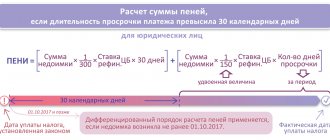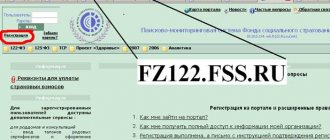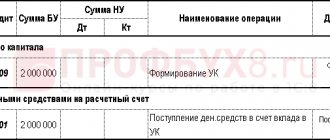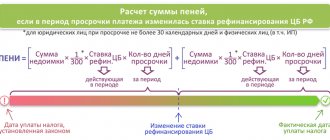Penalties are fees for late payment. Such sanctions, like fines, are possible not only for taxes, but also for contracts. Basically, penalties are calculated manually in 1C 8.3. The accountant immediately has a question about which accounts to use when calculating penalties in 1C 8.3 postings.
But are all penalties accrued by an Operation entered manually? We hasten to please you - this is not so! For example, the accounting of penalties under a contract in 1C 8.3 to the buyer is automated. For this purpose, the program provides a special document Accrual of penalties.
Let's figure it out:
- what entries must be made in accounting and in 1C 8.3 in order to accrue penalties for taxes and fees;
- how to calculate a fine in 1C 8.3 - we will reflect the entries in the accounting of the seller and buyer in case of violation of obligations under the contract.
For more details, see the online course: “Accounting and tax accounting in 1C: Accounting 8th ed. 3 from A to Z"
Fine: essence and types
Definition 1
A fine is a monetary penalty that is imposed on an organization due to a violation of a contract or legal requirements. The monetary penalty can be expressed either as a percentage or as a lump sum.
Types of fines:
- The tax penalty is displayed in the account: Dt 99 “Profits and losses” Kt 68 “Calculations for taxes and fees”;
- Fine for violation of contractual terms - Dt 76 “Settlements with various debtors and creditors”, subaccount “Settlements on claims” - Kt 91 “Other income and expenses”
- Administrative fine – Dt 91 Kt 76
- Payment of administrative bills - DT 76 - Kt 50 “Cash”, 51 “Cash accounts”, etc.
Note 1
Fines are accepted for accounting purposes in the amounts that were awarded by the court during the period when the decision on their collection was made.
Finished works on a similar topic
- Course work Posting fines in 1C 450 rub.
- Abstract Posting fines in 1C 280 rub.
- Test work Posting fines in 1C 190 rub.
Receive completed work or specialist advice on your educational project Find out the cost
Reflection of an administrative fine in the program
A fine can be entered into the 1C program as follows. Go to the “Operations” menu and select the “Operations entered manually” view. Click on the “Create” button and a form will open for you to fill out. You need to enter information about the name, date of the document, correspondence of accounts (debit and credit of accounts), the amount of the transaction and subaccount. Debit subconto is the counterparty, credit subconto is an item of other income and expenses from the directory “Directory of Items of Income and Expenses”. In this directory, select the article “Fines, penalties and penalties for receipt (payment)”. The amount of the fine is indicated in the document “Receipt to the current account” indicating the type of transaction “Other receipt”. Now you can post the document and the 1C program will display the transactions.
The operation for accounting for a fine is carried out through the operation “Operation entered manually”, but when filling out changes in the corresponding account and analytics appear. The changes occur due to the fact that fines and penalties are accepted for tax accounting. Therefore, the amount when posting a document will be reflected in both accounting and tax accounting.
Looking for ideas for study work on this subject? Ask a question to the teacher and get an answer in 15 minutes! Ask a Question
For what period are penalties accrued in housing and communal services in 2021?
Readers are asking whether penalties are now being assessed for the moratorium period in 2021, that is, for the period from April 6, 2021 to January 1, 2021. Such a moratorium was introduced last year by Government Resolution No. 424.
Are penalties accrued in 2021 for the period of the past moratorium?
Someone on the Internet believes that penalties (penalties) are now accrued and collected for the entire period, including most of last year. Perhaps this misconception is related to the fight against debtors - management companies are trying to scare defaulters in this way.
In this regard, we remind you that the Supreme Court of the Russian Federation has already given an answer to the accruals in paragraph 7 of its Review No. 2, approved by the Presidium of the Supreme Court of the Russian Federation on April 30, 2020. The question was: For which periods of delay in 2021 is a penalty not subject to accrual in the event of untimely and (or) incomplete payment for residential premises, contributions for major repairs and utilities established by housing legislation?
In its response, the Supreme Court of the Russian Federation writes:
- The moratorium applies to penalties (penalties, fines) subject to accrual for the period of delay from April 6, 2021 to January 1, 2021, regardless of the billing period for the provision of utility services for which there was a delay in payment, including if the amount of the main debt was formed before April 6, 2021, unless a different deadline for the end of the moratorium is established by law or legal act.
- The penalty is subject to accrual and collection in the manner established by housing legislation, legislation on gas supply, electricity, heat supply, water supply and sanitation, and the terms of contracts for the entire period of delay, excluding the period of the moratorium .
- If the decision to collect the corresponding penalty is made by the court before January 1, 2021, then in the operative part of the decision the court indicates the amount of the penalty calculated for the period until April 6, 2020. Regarding claims for the collection of the penalty before the actual fulfillment of the obligation, the court rejects them as filed prematurely . At the same time, the court explains to the applicant the right to make such a claim in relation to the days of delay that will occur after the end of the moratorium.
When collecting debt, courts cite these clarifications and add that in the future, plaintiffs can apply for the collection of penalties (penalties) for the period from January 1, 2021, for example, in this way:
- “...In this regard, the accrual of penalties (fines) in the period from 04/06/2020 is unacceptable. At the same time, the plaintiff is not deprived of the right to make a further claim for the recovery of a penalty (fine) for the period from 01/01/2021, taking into account current regulatory legal acts" (Decision of the Arbitration Court of the Sverdlovsk Region in case No. A60-34485/2020 on recovery from the owner of non-residential premises owes payment for thermal energy).
The issue on which judicial practice really diverges is the calculation and collection of penalties from owners of non-residential premises.
There was an example above where the owner of a non-residential premises was released from penalties during the moratorium period. However, this does not prevent the higher court in the same region from collecting penalties from the owners of non-residential premises for the period of the moratorium:
- “the moratorium on the accrual of penalties (fines, penalties) is established only in relation to the owners of residential premises, while in the case under consideration the subject of the dispute is payment for the supplied utility resource to the non-residential premises of the defendant, and therefore, in this part, the moratorium does not apply to the defendant” (Resolutions of the Seventeenth Arbitration Court of Appeal in cases No. A60-5216/2020, No. A50-7642/2020, No. A50-7770/2020, etc.).
Some other courts (we can’t vouch for all of them) take into account the moratorium period to determine the amount of the penalty in relation to the owners of non-residential premises (Resolution of the Eleventh Arbitration Court of Appeal in case No. A55-25264/2019 on the collection of debt for services for the management, maintenance and routine repairs of common property of an apartment building ; Seventh Arbitration Court of Appeal in case No. A27-9838/2020 on debt collection for housing and communal services).
If you are the owner of non-residential premises in an apartment building and you need to justify to the resource supplying organization why exemption from penalties also applies to non-residential premises, take the Resolution of the Eighteenth Arbitration Court of Appeal dated November 26, 2020 in case No. A76-25179/2020 on debt collection under an energy supply contract. There, the plaintiff indicated in his complaint that the owner is not subject to the moratorium, and the court described in great detail why he thinks otherwise. Briefly it will be like this:
- As directly follows from the name and content of Resolution No. 424, its provisions apply to the provision of utility services to owners and users of premises in apartment buildings and residential buildings, that is, to both owners of residential and owners of non-residential premises.
- Paragraph 1 of Resolution No. 424 concerns the suspension of the provisions of legislation, and paragraph 2 of Resolution No. 424 concerns the application of the provisions of contracts containing provisions for the provision of public services, taking into account the suspension of certain regulations during the period of such suspension.
- The provisions of paragraphs 1 and 2 of Resolution No. 424 apply to the owners of non-residential premises of apartment buildings (in this case, the defendant in the case); on the provision of public services in such premises (including the supply of heat and electricity), including public services for the management of municipal solid waste.
- Disputed legal relations are not subject to the provisions of paragraph 5 of Resolution No. 424, since this paragraph concerns payment for residential premises and utilities and contributions for major repairs for such premises, and the defendant is the owner of non-residential premises. When stating the arguments of the appeal, the plaintiff reasonably indicated that the provisions of paragraph 5 of Resolution No. 424 were not applied to the controversial situation, however, the possibility of applying paragraphs 1 and 2 of Resolution No. 424 to them, taking into account the above, was not assessed.
- The appellate court agrees with the conclusions of the first instance court that there are grounds for suspending the collection of penalties from 04/06/2020 on the basis of Resolution No. 424, since such grounds are established in accordance with paragraphs 1 and 2 of Resolution No. 424.
Payment of the penalty
You can enter information about paying a fine into the 1C program using the “Receipt of Goods” document. When creating a document, select the type of transaction “Write-off from current account”. In the open window, fill in the information about the date, number, contract, DDS article. Post the document. Now you can generate a document for payment of penalties. This payment can be made in the “Bank and cash desk” menu, in the “Bank” section, “Bank statements” item. When you click on the “Bank Statements” hyperlink, click on the “Write-off” button and fill out the document “Write-off from the current account” indicating the type of transaction “Payment to the supplier.” You also need to fill out information about the date, recipient, amount of the fine, agreement and settlement account 76.02.
Calculation of penalties for taxes
Tax penalties are calculated in the 1C program using the “Other income and expenses” directory element. For business contracts, fines are taken into account in income and expenses to determine the tax base when calculating income tax. Make sure that the “Accepted for tax accounting” checkbox is checked in the directory element.
Fines to government agencies (fines for taxes, for violating traffic rules, etc.) are not accepted in tax accounting. Therefore, the best solution is to create two different elements of the “Other income and expenses” directory. And now for each fine you will choose the appropriate one.
After selecting a directory element, you need to pay the debt to the supplier and the amount of the fine. To do this, you can generate a document “Write-off from the current account” and upload documents from the bank, or you can open the “Purchases” menu, the “Receipts (acts, invoices)” section and find the “Purchases” document.
Need advice from a teacher in this subject area? Ask a question to the teacher and get an answer in 15 minutes! Ask a Question
Calculation of insurance premiums in 1C 8.3 Accounting
The program “1C Accounting 8.3” (rev. 3.0) allows, in accordance with current legislation, to calculate and accrue all necessary insurance contributions to employees’ salaries for the purpose of further payment of contributions and reporting. In order for the automatic calculation of contributions to be correct, the appropriate settings must be made in the system.
Contribution accounting settings
The taxation system used in the organization must be indicated in the accounting policy. Settings related directly to contributions are set in the same form as “salary settings”:
Salary and personnel/ Directories and settings/ Salary accounting settings
Here, in subsection 1C 8.3 “Contributions: tariffs and income”, you can preview background information: a list of current discounts, types of contribution income, values of the maximum base value, types of tariffs.
All these directories are already filled by default with data that is relevant at the time of release of the current version of the program. It is possible to add or edit them manually.
To directly set up contributions, you need to go to the “Main” subsection in the same form and open the salary accounting settings form for the organization. In it, on the “Taxes and Payroll Contributions” tab, you should fill in:
- Type of insurance premium rate and the period from which it is valid. Tariff types are available that correspond to the applicable taxation system (OSN, simplified tax system, UTII).
- Parameters for calculating additional contributions . If our organization employs people in professions such as pharmacists, miners, members of flight crews or crews of sea vessels, you need to check the box and fill out a list of positions or ships for this category (they are available via the links). Marks are also placed here in case of employment of workers in difficult or harmful working conditions and the use of a special assessment of working conditions.
- Contributions from NS and PP . It is necessary to indicate the contribution rate approved for the organization by the Social Insurance Fund.
Charges subject to contributions in 1C
Each employee is assigned an accrual for payroll calculation. There are also accruals for paying sick leave or vacation. All of them are available in the accrual directory.
Salaries and personnel/ Directories and settings/ Accruals
Get 267 video lessons on 1C for free:
In the accrual form there is a “Type of income” detail, which determines whether this accrual will be subject to contributions. The reference book already contains the accrual “Payment based on salary”, which has the type of income “Income fully subject to insurance contributions”, and accruals for sick leave with the type of income called “State benefits of compulsory social services”. insurance paid at the expense of the Social Insurance Fund.”
If you need to create new accruals, you must correctly indicate the type of income for them.
Cost items for insurance premiums
Cost items are needed for proper accounting of contributions. The program already has articles that are used by default: “Insurance contributions” and “Contributions to the Social Insurance Fund from NS and PZ” (as well as similar articles for UTII). Their list is in a special directory. Please note that cost items for contributions are “tied” to cost items for accruals.
Salaries and personnel / Directories and settings / Cost items for insurance premiums
If you need to use other items, you can add them to the directory, indicating the connection with cost items for accruals.
Calculation of insurance premiums
This operation is performed automatically by the standard document 1C 8.3 Accounting “Payroll” simultaneously with payroll.
Watch our video about step-by-step payroll in 1C:
Salary and personnel/ Salary/ All accruals
Once employee accruals are completed, the Contributions tab displays the calculated premiums. The calculation is carried out according to the type of contribution tariff for a given organization, as well as the types of income accruals.
When carried out, this document, in addition to postings for payroll, also generates accounting entries for calculating contributions.
Postings are made to the debit of the same accounting accounts to which the salaries of these employees are attributed, and to the credit of the subaccounts of accounting account 69 “Calculations for social services”. insurance and security."
Cost items for insurance premiums are used as analytics.
Analytical reports on insurance premiums
Salary and HR/ Salary/ Salary reports
The report “Taxes and contributions (briefly)” – displays for a given period for each employee and a summary of accrued contributions and personal income tax.
The report “Analysis of contributions to funds” - displays an analytical table for each type of contribution in the context of tariff types and charges, displaying non-taxable charges and excess of the maximum base (if any).
Here, in the “Salary Reports” section, a unified “Insurance Contributions Accounting Card” is available. It can also be generated from the “Payroll” document (the “Contributions” tab).
Unfortunately, we are physically unable to provide free consultations to everyone, but our team will be happy to provide services for the implementation and maintenance of 1C. You can find out more about our services on the 1C Services page or just call +7 (499) 350 29 00. We work in Moscow and the region.
Source: //programmist1s.ru/nachislenie-strahovyih-vznosov-v-1s-buhgalteriya-8-3/






